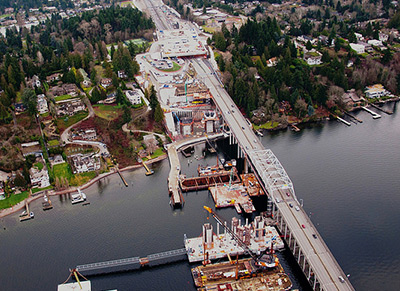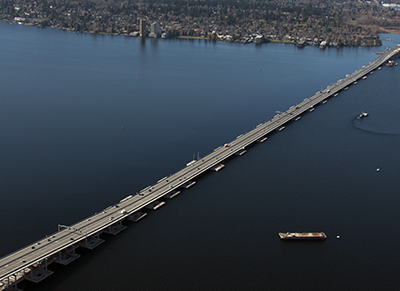AUDIO
MP3 Download: Listen to Julie Meredith, P.E., SR 520 Program Manager at the Washington State Department of Transportation, talk about the evolution of the SR 520 Corridor.
RESOURCES
- Evergreen Point Bridge Written Narrative (pdf 8.3mb)
- Evergreen Point Bridge - Field Records (pdf 480 kb)
Links to external websites do not constitute endorsement by WSDOT of the linked websites or the opinions, information, products or services contained therein.
Past to Present: Connecting the region, re-connecting communities
I
n 1997, the State Transportation Commission created the Trans-Lake Washington Study to evaluate a variety of transportation options to address growing traffic gridlock across Lake Washington. Initial options included expanding the existing SR 520 corridor, building a new bridge between Sand Point and Kirkland, and studying new passenger ferries. The Trans-Lake Washington Project, launched in 1999, built on the study’s efforts by narrowing a decision to replace SR 520 with a reconstructed highway and new, safer bridge.
Environmental laws passed since the first SR 520 floating bridge was built changed the process for determining how the new bridge would be built. The National Environmental Policy Act, passed in 1970, and the State Environmental Policy Act, passed in 1971, contained provisions that required public agencies to conduct environmental reviews of proposed projects to identify which natural and historic resources would be affected. The laws require that those effects be minimized, and, where the effects are unavoidable, mitigation projects be carried out.
Laying the groundwork for a new corridor
In 2003, the environmental process for a new SR 520 began, and included a full evaluation of multiple design options and four-, six- and eight-lane configurations from I-5 in Seattle to the Eastside. A draft environmental impact statement was published in 2006.
In 2007, the Legislature authorized a mediation process among communities on the west side of SR 520 and other key stakeholders to narrow design options for the west side of the corridor. At the end of mediation, three design options were identified for further analysis in the supplemental draft environmental impact statement: Options A, K and L.
Following publication of the supplemental draft environmental impact statement, then Gov. Christine Gregoire gathered with other transportation and legislative leaders to announce the preferred alternative for the west side of the SR 520 corridor. This announcement in spring 2011 followed several years of legislative discussion, public engagement, and thorough technical analysis.
In August 2011, WSDOT finalized the environmental documentation process and the Federal Highway Administration (FHWA) signed the Record of Decision. The Record of Decision lists WSDOT and FHWA’s commitments to the surrounding community, including the executed Section 106 Programmatic Agreement. That same month, WSDOT awarded a contract to build the new floating bridge.
At the same time, planning and design continued on the west side of the corridor. WSDOT and its regional partners launched the Seattle Community Design Process, a series of public design workshops for the new SR 520 highway between I-5 and the west end of the floating bridge. By the end of 2012, this process encompassed seven public open houses, three new Portage Bay Bridge designs, two lid options for the Montlake interchange, and more than 1,600 public comments.
The environmental impact statement process identified a number of natural and historical resources that could not be avoided with the preferred option and required mitigation. WSDOT identified shoreline improvements along Lake Washington – in Washington Park and the Union Bay Natural Area – to mitigate for loss of habitat in the project area. To mitigate for the impacts to cultural and historic resources in the neighborhoods on the west side of the lake, WSDOT committed to carrying out several other projects as well.
Construction begins
Pontoon construction was the first SR 520 construction project to begin, launching in Aberdeen in February 2011. Crews constructed a 4-acre casting basin at a site on the banks of the Chehalis River in Grays Harbor County, where 33 pontoons would be built. Crews also constructed pontoons in Tacoma under a separate contract.
Eastside construction launched in April 2011 when crews began work to expand SR 520 to six lanes from Medina to Bellevue, and build three new community-connecting lids across the highway, eight fish-friendly culverts, and other transportation and environmental upgrades.
In 2012, construction for the new floating bridge started. In August 2012, the first new SR 520 bridge pontoon was towed through the Hiram M. Chittenden Locks in Ballard. Crews joined 77 pontoons together, installed bridge piers and roadway decks, and completed numerous other elements on the new floating bridge before it opened to traffic in April 2016.
The next major effort for SR 520 began in 2014, with the start of construction of the north half of the new west approach bridge, connecting the floating bridge to the Montlake area. Following completion of this bridge in 2017, WSDOT continued moving west, with reconstruction of the SR 520 corridor between Lake Washington and I-5 kicking off in 2018.

